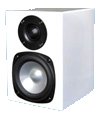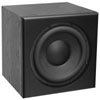Reviews
Joey 2
AUSTRALIAN HIFI April/May 2003
Mini-monitors are intended to be used recording studios, where they are usually (but not always!) positioned at either end of the mixing desk. Because their frequency response is so flat and they are so close to the listening position, mini-monitors reveal the subtlest phase-shifts between channels, as well as tiny differences in volume level. This level of accuracy is essential in order to allow the mixing engineer(s) to hear exactly what's going onto the master two-track recording that will be used to press the final CDs. (The fact that many studio mini-monitors end up on the desks of various executives working in those same studios is by-the-by!).
Why review what is essentially a professional monitor? The fact is that mini-monitors have started making their way into homes. There's no doubt this is at least partly a function of their size (at 272mm high, 188mm wide and 245mm deep Legend's Joey 2s look positively tiny on a bookshelf or on a speaker stand), with modern consumers searching out ever-smaller speakers, but with the Joey 2s, they get highly accurate sound as well.
The Equipment
Having said in the introduction that the Joey 2 is a mini-monitor, I feel obliged to point out that it actually has a much bigger bass driver than is usual for a mini-monitor, which is made possible because the cabinet, although small, is a fraction larger than a typical mini-monitor. The increased cabinet size means an increased cabinet volume, which in turn-in combination with the large bass driver-means a deep, extended bass response..
Because two-way designs require that the bass driver must also reproduce midrange frequencies, designer Rod Crawford (formerly a speaker designer with Linn Products in Scotland) has elected to use a bass driver from the French manufacturer Audax. This unit has a cone made from aerogel, a material with a more natural tonal quality than polypropylene and better physical stability than paper. Rather than use a standard aerogel driver from Audax, Legend fits a magnetically shielded version, the cone of which is specially mass-loaded to make it work more efficiently in the Joey 2 enclosure. The mass loading appears to be added by hand in what I imagine is a fairly elaborate and fiddly process that must take quite some time to apply to each and every driver. The Audax driver has an overall diameter of 150mm, but the Theile/Small diameter is 113mm.
The aerogel cone is terminated with a rubber roll surround. The driver in question uses an exposed pole-piece with a rubber phase plug. Because the voice-coil former is exposed, it's better to leave the grille-cloth on these speakers, rather than the 'naked' (sans grille) look preferred by many audiophiles.
Another excellent reason to keep the grille-cloths in place is so your friends don't constantly tell you that your speakers are upside-down! (You probably have already noticed from the product photograph that Rod Crawford ascribes to the 'inverted geometry' favoured by UK manufacturer Mission, and others). Dr Crawford says he has two primary reasons for putting the tweeter below the mid/bass unit, the first of which is that because the tweeter is not recessed into the baffle, it means the 'on-axis' line is slightly upwards. If the speaker stands are the usual size (and one needs very tall ones for them to be at ear level) then a listener is more likely to be near axis. The owners' manual does point out that if the speakers are mounted above ear-level, the speakers should be inverted so the tweeters are uppermost.
Dr Crawford's second reason for the upside-down geometry is that he feels (and I agree) that accurate midrange reproduction is more important than accurate high-frequency reproduction, because this is where most musical information is positioned in the audio spectrum, and by placing the midrange upper-most in the baffle, it's more likely to be further from secondary reflecting surfaces, even if the speakers are on stands, so there will be fewer early reflections to affect the sound.
Reflections can have a considerable effect on speaker performance, and everywhere you look on the Joeys, Legend has made sure it minimises reflections. Take a very, very close look at the baffle, for example, and you will notice the drivers are not positioned 'evenly' on the baffle. This is because Legend has positioned them so the distances from the drivers to the edges of the cabinet are unequal, a trick that tends to negate diffraction effects. Legend calls this 'radically asymmetric' positioning.
Reflection/diffraction effects are further minimised because, like all Legend speakers, the Joey 2s do not have a reflection-inducing grille frame. Rather than use a grille frame, Legend routes a groove around the outside of the cabinet, which tensions the grille cloth, thanks to a length of strong elastic that's sewn around its edge. I've commented on this design approach before, saying that it's a brilliant idea, but to the best of my knowledge, Legend remains the only manufacturer using it. I guess the fact the cloth has to be hand-sewn makes the process too expensive for most other speaker makers.
The tweeter, which is made in Denmark for Legend by Peerless, has a 25mm fabric dome and although it is mounted in a fairly large front-plate, is not horn-loaded.
Whereas in the past all the Legend loudspeakers I have reviewed have used van den Hull cable for their internal wiring I discovered the new Joey 2 uses locally-produced 'Monitor OFC' cable, with each conductor comprising 23 strands of oxygen-free copper, insulated with foamed insulation, which Dr Crawford prefers to PVC. Although vdH is still used in some models, others, such as the Kantu, are now wired with Cardas cable. As you'd expect, the drivers are hard-wired back to the crossover network, which is also hard-wired. The crossover looks complex, but this is simply because Legend is paralleling components to gain greater transparency. The two air-cored coils are cross-mounted, but the smaller of the two is mounted almost inside the langer one, so some interaction between the magnetic fields seems inevitable despite the cross-mounting.
Listening Sessions
Visit Legend's website and you'll run across the following warning: 'We have taken great tare to minimise colouration, particularly resonances, that give many speakers a 'warm but fuzzy' sound - and make all recordings sound 'nice', much like bathroom resonanees make us all sound like operatic tenors or sopranos ...[but] ... if they are fed poorly recorded music or through poor front end electronics, the Joey 2s will sound poor. Conversely, fed with well-recorded music (e.g. a Telarc SACD) through high quality front-end electronics, the Joey 2s will sound superb.'
I have to say that it is not often that a speaker manufacturer warns its customers that one of its own models might rot sound good, but in this case, and having lived with the Joey 2s for more than a month, I think I am safe in saying that Legend must have a lot more poorly recorded music in its collection than I have in mine, because I found it difficult to find any recording that made the Joey 2s sound 'poor'!
Sure I found one or two CDs that had been badly recorded in the first place that didn't fare so well, but I don't think they actually sounded 'poor'. Instead the Joey 2s just revealed exactly in which way the original engineers had erred during the recording and/or mastering process: whether it was incorrect microphone placement, heavy-handed work on the mixing desk or just plain bad sound balancing.
For my listening sessions, I placed the Joey 2s on ordinary sand-filled steel speaker stands, about one metre from a wall and listened from a comfy couch that was definitely in the far-field, about three metres away. In this set-up, I thought the sound quality was fabulous, most particularly across the midrange, where the sound was precise and unfailingly accurate. On well-recorded discs, such as the new one of Beethoven and Mendelssohn concertos by violinist Joshua Bell (Sony SK 89505), the sound was outstandingly good. Given that you can't expect much bass from such a small cabinet/driver combination, bass response was nonetheless a stand-out.
I also tried listening in the near-field (from two metres away), with the speakers placed closer together, and found the sound improved even further, with a much more 'focused' quality to the stereo image, but also more of a 'wall of sound' effect. At this closer distance, I found tihe speakers had to be angled in towards the listening position to achieve the same low frequency/high frequency balance I enjoyed so much in the far-field listening position.
Conclusion
In their class, the little Joey 2s are real world-beaters, and in-my opinion, easily Legend's best design yet (though I note from the commentson Legend's website that Dr Crawford is of the same opinion). It's worth remembering that although they're designed as monitors, the fact that they're shielded means you can use them as left and right (and centre!) in a home theatre set-up, and of course they'd be fabulous in the surround-charnels. I even tried them out with my computer, running the output from the soundcard through, a small integrated amplifier and thence to the Joey 2s. Magic!
Greg Borrowman






